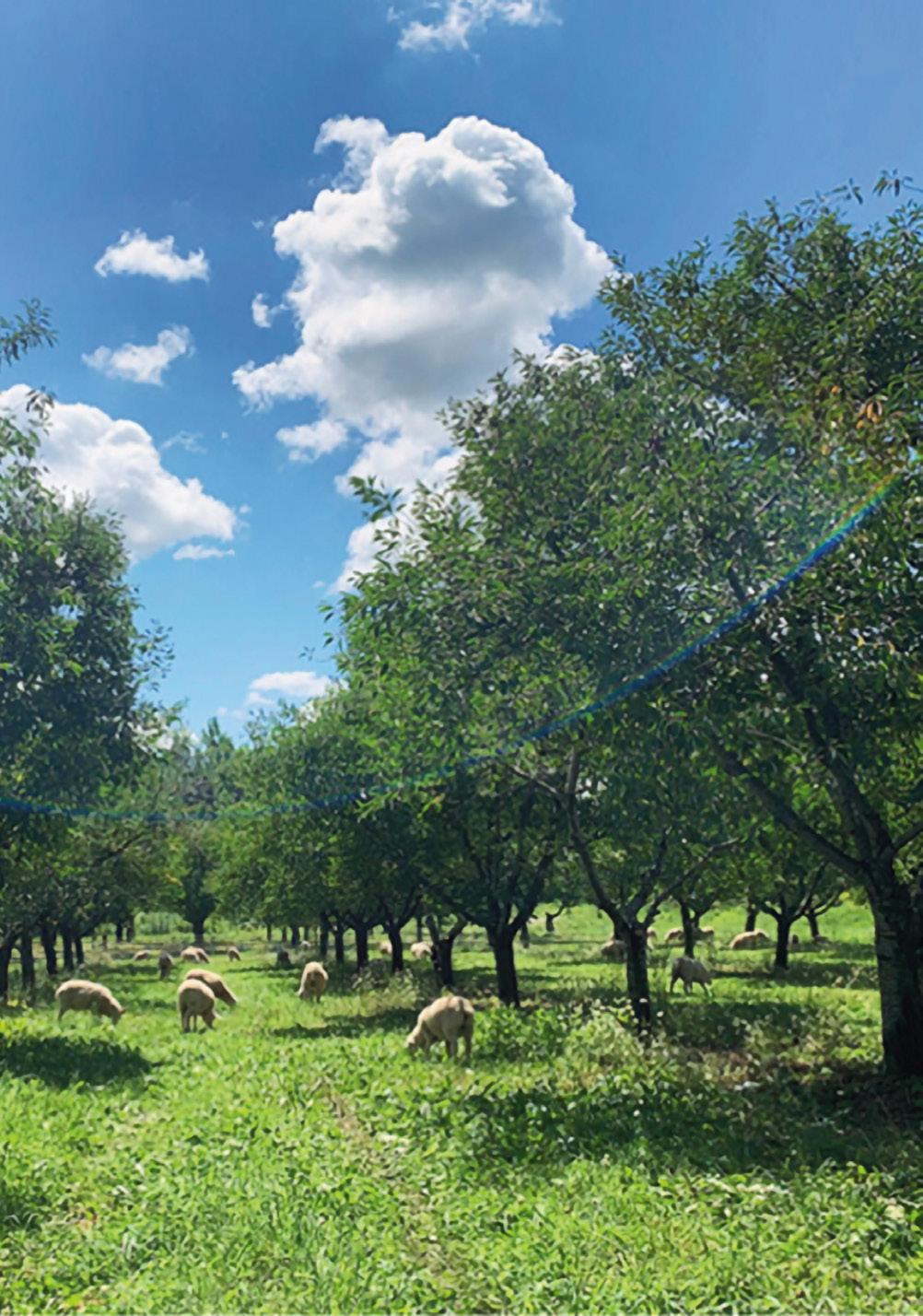
4 minute read
Sheep Can Help Mitigate Climate Change
There is a misconception that farming is bad for the environment—it has been suggested that farmers are partially responsible for deforestation, water pollution, and stripping soil of vital nutrients. However, farmers and their livestock contribute to the environment in ways that continuously support sustainability and biodiversity, which is often overlooked.
Ontario’s sheep farmers, for example, play an integral role in the management of grasslands (land covered with grass and other low plants suitable for grazing animals). When sheep graze in pastures, they play a crucial role in improving soil health, enhancing biodiversity, retaining soil organic matter, and increasing soil’s biological activity. Grazing sheep are moved from pasture to pasture, giving grasses a rest period to regrow and develop more roots. Their hooves help mix manure with soil, fertilizing it and building organic matter. This action opens the soil, seeds it, and allows plant roots to go deeper—all without the need for tilling or ploughing.
Sequestering carbon is another way that Ontario’s sheep farmers benefit the environment. Managed correctly, sheep help mitigate degraded soils and restore healthy ecosystems, which helps lock carbon deep in the ground. Grasslands can store up to 200 tonnes of carbon per hectare in the roots, grasses, and shrubs. That is equal to offsetting the carbon emissions of 3.62 million cars per year! If managed grazing could be implemented worldwide, it could sequester over 16 gigatons of carbon by 2050.
Sheep farmers in Ontario use innovative grazing techniques, such as silvopasture, orchard grazing, and grazing solar installations. These multi-use approaches to land not only provide habitats for pollinators and birds while building soil carbon, but it also decreases fossil fuel use through a major reduction in mechanical mowing of these areas.
Another useful benefit that sheep contribute to biodiversity is providing a habitat for grassland birds. Grasslands are richly biodiverse and are home to over 1,000 species of animals, pollinators, and other insects. The Ontario Sheep Farmers work with Bird Ecology and Conservation Ontario to implement nesting habitats for endangered and threatened species, such as the bobolink and the eastern meadowlark, on farms, increasing awareness of the value of agricultural grasslands for wildlife.
Ontario Sheep Farmers are committed to healthy soils and clean water and takes its responsibility seriously by providing leadership on the Lake Erie Phosphorus Ag Sector Working Group. This group has brought industry and government together to provide advice on potential actions by agriculture and government to reduce phosphorus entering Lake Erie.
It is possible to include lamb in your diet and still care for the environment. We know we have a responsibility to be part of the solution, and part of that includes sharing how livestock can positively impact the environment.

To learn more about the positive impacts of livestock farming, visit ontariosheep.org


Cranberry Orange Ontario Lamb Chops
Preparation time: 1 hour | Cook time: 40 minutes | Makes: 2 servings
Lamb doesn’t have to be reserved for special occasions!
Lamb meat is a good source of iron and vitamins and has protein that is rich in essential amino acids, and deserves a spot on your table any night.
It is particularly rich in vitamin B-12 and in niacin, zinc, and iron. Just 3 oz of cooked lamb, with any excess fat removed, provides the average person with 48% of their daily protein requirements, 30% for zinc, 10% for iron, 37% for vitamin B-12, and 27% for niacin.
A good quality lamb will have a nice fat finish, which not only adds flavor to the lean meat, but can also be—in the right amount—a healthy part of a balanced diet. Only one third of fat in lamb is saturated, the rest is mono or polyunsaturated, the “good” fat in one’s diet. The majority of the fat is on the edges of the meat, which means that the excess fat is easily trimmed off, leading to fewer calories!
With the holidays right around the corner, it’s time to shake things up. This delicious lamb chops recipe will make for an easy and tasty dinner that even looks fancy.
INGREDIENTS
• 6 Lamb Chops (Frenched) or 4 Loin Chops 1” thick
• ½ cup sugar
• 1 cup cranberries
• ¼ cup orange juice
• 1tsp grated orange rind
• 1 tsp Dijon mustard
• Pinch of allspice
DIRECTIONS
1. In a small saucepan over medium heat, combine sugar, cranberries, orange juice, rind, Dijon mustard, and allspice.
2. Cook until mixture boils and cranberries pop (about 10 to 12 minutes). Set aside.
3. In a preheated broiler, 4” from heat, broil lamb chops on one side for 6 minutes.
4. Turn chops and broil 4 minutes longer.
5. Spoon one generous teaspoonful of sauce over each chop. Broil for 1 minute longer.
Serve extra sauce on the side. Serve with parsley potatoes and vegetables julienne.
Looking to Buy Fresh Premium Ontario Lamb try using our lamb locator tool at
LAMBRECIPES.CA










